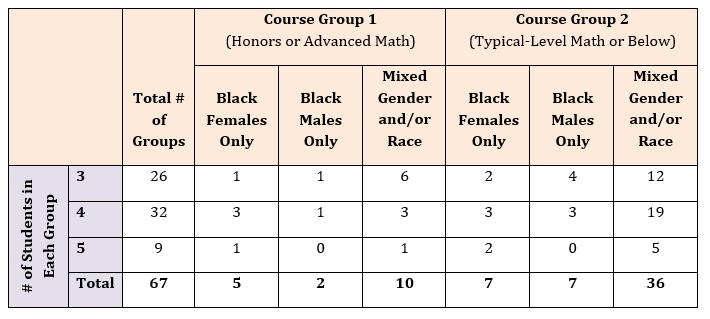Student Focus Groups & Interviews
Focus Group Timeline
We conducted focus groups on this project at two timepoints:
- During the fall of 2016 (when most students were in 8th grade).
- During the fall of 2019 (when most students were in 11th grade).
Information about each of these focus group timepoints is presented below.
8th Grade Focus Group/Interview Description
Purpose:
Math performance for this group of 500+ middle school students is at least two grade levels behind and growing worse each year. But three years of paper and pencil surveys of student attitudes toward math and evaluations of their math abilities yielded highly positive and unrealistic perceptions. Surveys of the students’ math teachers indicated that teachers had recalibrated their expectations of these students. In an attempt to develop a deeper understanding of the perceptions of both teachers and students, we implemented student focus groups and teacher interviews in the fall of 2016, when most students were in the 8th grade. Students unavailable for a group meeting were individually interviewed.
Creating the Protocol and Training Staff:
- A component of the focus group procedure involved sorting photographs that depicted math activities and professions involving math. These were intended to spark discussion. Photographs were chosen and three groups of cards were created for piloting.
- A student-focus group script and student-interview script was created for each session type.
- Four pilot sessions were conducted (3 focus groups; 1 interview).
- Staffing for each student focus group consisted of a group facilitator and a note taker. Each group session was also audiotaped. These tapes supplemented the notes. Each student interview only consisted of a facilitator.
- Two and a half days of training were provided. Training focused on learning to perform reliably both the tasks of a facilitator and that of the observer.
- Notes on focus group discussion were recorded in real time by the observer.
- Interviews were transcribed by the facilitator using the audio recorder after the session.
Protocol: Click here to view the 8th grade focus group/interview protocol.
Card Sort Images:
- Click to view the Middle School Cards
- Click to view the Professions Cards
- Click to view the Elementary School Cards
Student Data:
Students are largely clustered in schools within the district; 45 of the 47 schools in the district have 2 or more students from our sample enrolled (473 students). Twenty-two of the schools have 10 or more students enrolled or 342 students from our sample. Therefore, with some interviews, our focus group sizes ranged from 2-6 students from the same school. The remaining students in the study were spread out among an additional 20 schools, both within the district and contiguous counties. Those students were given card–sort only.
NOTE: We conducted 174 total focus group and interview sessions. However, 1 student had to leave school after completing Topic 1 (Middle School) in a focus group. He completed the Professions and Elementary School sections on another day during in an individual interview.
Data Coding:
After the data collection period ended, a team of 6 coders were trained, and the data were coded using FileMaker software.
11th Grade Focus Group/Interview Description
Purpose:
The 11th grade focus groups were designed to gather students’ perspectives on their math experiences and identity and their plans for the future. By having targeted subgroups for some of the focus groups, we hope to be able to find interesting and important contrasts in the perspectives of students based on race and gender. We structured these groups to provide an opportunity for students’ voices to be heard.
Creating the Protocol and Training Staff:
Five trained facilitators conducted focus groups. The majority of the facilitators were middle-aged white women. One was a middle-aged black woman. Each trained facilitator participated in an extensive reliability process to ensure their preparation to conduct focus groups.
Protocol:
We restricted the 11th grade focus groups to only include students who were in-district and enrolled at a school where a minimum of 5 of our study participants were enrolled. In addition, we did not conduct focus groups at the alternative schools.
For the focus group sessions, students were grouped by course level.
- Group 1: Students who (1) were enrolled in an honors math course, and/or (2) were taking an advanced math course for their grade (e.g., in Integrated Math III as a 10th grade student).
- Group 2: Students who were in the typical-level class for their grade or below.
When possible, we also grouped students by gender and race (black or non-black).
Focus group sessions were conducted in a quiet space within students’ schools. Group size ranged from 3-5 students, and each session was led by one trained focus group facilitator. On average, the sessions lasted 30 minutes. Each session was audio-recorded, and after the session ended, the facilitator used a custom-built FileMaker database to record the students in the focus group, as well as notes about group dynamics, participant roles, and any non-verbal cues that the students made during the session.
Click here to view our 11th grade focus group questions.
Student Data:
Of the 368 “active” students who met the criteria listed above (e.g., in-district), 251 students completed a focus group session. The remaining students were not available to complete a focus group session due to things like absenteeism, class scheduling conflicts, or because the student did not fit into a needed focus group category.
In total, 67 focus group sessions were conducted during the fall of 2019.
Data Coding:
Project staff is currently developing a coding scheme for the 11th grade focus group data, and we expect to begin coding soon.

